
Guadalajara is a metropolis in western Mexico and the capital of the state of Jalisco. According to the 2020 census, the city has a population of 1,385,629 people, making it the 7th largest city by population in Mexico, while the Guadalajara metropolitan area has a population of 5,268,642 people, making it the third-largest metropolitan area in the country and the twentieth largest metropolitan area in the Americas Guadalajara has the second-highest population density in Mexico, with over 10,361 people per square kilometer. Within Mexico, Guadalajara is a center of business, arts and culture, technology and tourism; as well as the economic center of the Bajío region. It usually ranks among the 100 most productive and globally competitive cities in the world. It is home to numerous landmarks, including Guadalajara Cathedral, the Teatro Degollado, the Templo Expiatorio, the UNESCO World Heritage site Hospicio Cabañas, and the San Juan de Dios Market—the largest indoor market in Latin America.

Tourism in Mexico is a very important industry. Since the 1960s, it has been heavily promoted by the Mexican government, as "an industry without smokestacks." Mexico has traditionally been among the most visited countries in the world according to the World Tourism Organization, and it is the second-most visited country in the Americas, after the United States. In 2017, Mexico was ranked as the sixth-most visited country in the world for tourism activities. Mexico has a significant number of UNESCO World Heritage sites, with the list including ancient ruins, colonial cities, and natural reserves, as well as a number of works of modern public and private architecture. Mexico has attracted foreign visitors beginning in the early nineteenth century, with its cultural festivals, colonial cities, nature reserves and the beach resorts. The nation's temperate climate and unique culture – a fusion of the European and the Mesoamerican – are attractive to tourists. The peak tourism seasons in the country are during December and the mid-Summer, with brief surges during the week before Easter and Spring break, when many of the beach resort sites become popular destinations for college students from the United States.
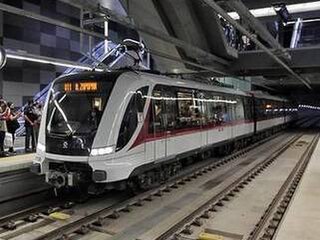
The Sistema de Tren Eléctrico Urbano, is an urban rail transit system serving the Guadalajara metropolitan area, in the municipalities of Guadalajara, Zapopan and Tlaquepaque, in the state of Jalisco, Mexico. It is owned by the state of Jalisco, and is operated by the state authority SITEUR. Opened in 1989, the system consists of three lines: Line 1, running from north to south with 20 stations; Line 2, running from the city center to the east with 10 stations; and Line 3, running from the north-west to south-east with 18 stations. A fourth line is under construction, which will run from the city center to the south of the metropolitan area.

Manuel Vicente Tolsá Sarrión was a prolific Neoclassical architect and sculptor in Spain and Mexico. He served as the first director of the Academy of San Carlos.
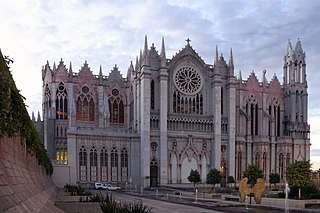
El Bajío is a cultural and geographical region within the central Mexican plateau which roughly spans from north-west of the Mexico City metropolitan area to the main silver mines in the northern-central part of the country. This includes the states of Querétaro, Guanajuato, parts of Jalisco, Aguascalientes and parts of Zacatecas, San Luis Potosí and Michoacán.

The Hospicio Cabañas or Museum Cabañas in Guadalajara, Jalisco was one of the oldest and largest orphanage and hospital complexes in the Americas. Now turned into a museum, the main hall hosts the magnum opus frescoes of muralist painter José Clemente Orozco. The place was designated a UNESCO World Heritage Site in 1997.

Ixtlán del Río is both a municipality and municipal seat in the Mexican state of Nayarit. In 2018 the population of the municipality was 33,289 and the total area was 581.4 km².
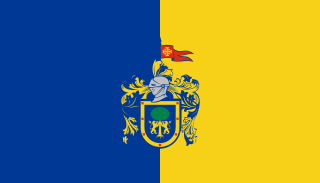
Jalisco, officially the Free and Sovereign State of Jalisco, is one of the 31 states which, along with Mexico City, comprise the 32 Federal Entities of Mexico. It is located in western Mexico and is bordered by six states, which are Nayarit, Zacatecas, Aguascalientes, Guanajuato, Michoacán, and Colima. Jalisco is divided into 125 municipalities, and its capital and largest city is Guadalajara.
Since the foundation of the New Kingdom of Galicia, the Mexican state of Jalisco has established itself as a main hub in the national economy and as the business centre of the western portion of the country. Although its economic strength is mainly concentrated in the capital, Guadalajara, the rest of the state enjoys a growing prosperity in diverse economic areas. Forest products are obtained along the coast, and mining for silver, gold, mercury, copper, and precious stones is an important activity. The beverage tequila, distilled from the juice of the agave cactus, is named for the town of that name in Jalisco and is one of the state’s best-known products. Since the state is home to two UNESCO World Heritage Sites, tourism is an important economic engine. In 2006 20 million local and international tourists visited the state, contributing to an economic revenue of 25 billion pesos, 11% higher than in 2005. Guadalajara is served by one of the country’s busiest airports and is one of the state’s major tourist centres. Puerto Vallarta is a popular tourist destination among young students. The state ranks number three in terms of nominal GDP behind Nuevo León State. Since the adoption of the North American Free Trade Agreement (NAFTA) in 1994 the state has been experiencing a high rate of investment. Jalisco, like many other industrial states in the country, has evolved from a producer of cheap, low-quality goods into an exporter of sophisticated products, from auto brake systems to laptop computers. 86% of the population is urban, higher than the national average of 76%.
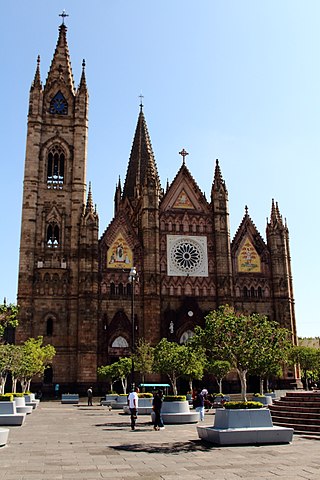
The Templo Expiatorio del Santísimo Sacramento is a Catholic church dedicated to the Blessed Sacrament, located in Guadalajara, Jalisco, Mexico. It is of neo-Gothic style and is considered the greatest work of its kind in Mexico. Its construction began on August 15, 1897 and ended 75 years later in 1972.
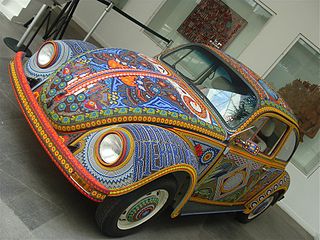
The Vochol is a Volkswagen (VW) Beetle that has been decorated with traditional Huichol (Wirrárika) beadwork from the center-west of Mexico. The name created by José Jaime Volochinsky is a combination of “vocho”, a popular term for VW Beetles in Mexico, and “Huichol”, the common name of the Wirrárika indigenous group. The project was sponsored by agencies associated with the Museo de Arte Popular, Mexico City, the states of Jalisco and Nayarit and other public and private organizations. The Volkswagen was covered in 2,277,000 beads applied by eight artisans from two Huichol families in an exclusive design based on Huichol culture.
The following is a timeline of the history of the city of Mexico City, Mexico.
The following is a timeline of the history of the city of León, Guanajuato, Mexico.
Federal Highway 15D is the name for toll highways paralleling Federal Highway 15. The toll segments of Highway 15D include some of the most significant highways in the country along the Nogales-Mexico City corridor. The highway is the southern terminus of the CANAMEX Corridor, a trade corridor that stretches from Mexico north across the United States to the Canadian province of Alberta.

Plaza Tapatía is an urban plaza in Centro, Guadalajara, in the Mexican state of Jalisco. The plaza is made of multiple smaller squares, Paseo del Hospicio and the Central Esplanade.

La sala de los magos is a sculpture by Alejandro Colunga, installed in 1993 outside Hospicio Cabañas in Guadalajara, in the Mexican state of Jalisco. Seven years later, Los magos universales, also by Colunga, complemented the artwork.
Los magos universales are several bronze benches by Alejandro Colunga, installed outside Hospicio Cabañas in Guadalajara, in the Mexican state of Jalisco. The sculpture was installed around 2000 to complement La sala de los magos, also by Colunga.

Templo de Nuestra Señora del Carmen is a church in Centro, Guadalajara, in the Mexican state of Jalisco. The building, whose construction began in 1690, is considered an example of neoclassical architecture following a 19th-century renovation that resulted from the widening of the avenue on which it's located.

Las Danzarinas are a group of fountains installed between Plaza Tapatía and Hospicio Cabañas in Guadalajara, in the Mexican state of Jalisco. Also known as "Del Espejo" and "Fuente Danzarina", then fountain is a replica of one at Taj Mahal.

Line 3 of the Guadalajara urban rail system is the third public transport railway line in the Guadalajara metropolitan area (México) and currently the longest in it. The line connects the Historical Centres of Zapopan, Guadalajara and Tlaquepaque, through the Diagonal Metropolitan Vial Corridor; consisting of Juan Gil Preciado, Juan Pablo II, Manuel Ávila Camacho, Alcalde / 16 de Septiembre and Revolución / Francisco Silva Romero avenues, from the Arcos de Zapopan neighbourhood until the Central Camionera Oriente of Guadalajara. It has 18 stations from south-east to north-west, of which 13 are elevated and 5 are underground; along 21.5 km. It is estimated that the line moves 233,000 daily passengers.
















